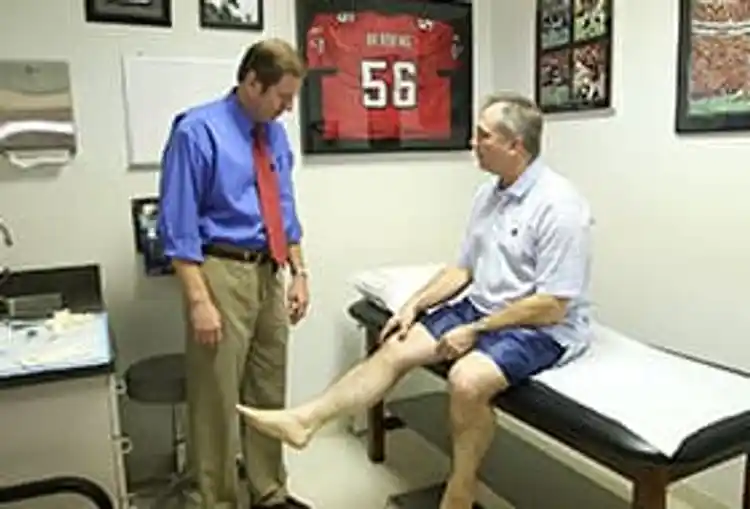Injections for Knee Pain

Hide Video Transcript
Video Transcript
THOMAS H. MYERS
Any problems with this knee? SUBJECT 1
No. You know, it hurts every now and then. THOMAS H. MYERS
Injections for knee pain are one of many different treatments that we can offer patients depending on their diagnosis. Most of the time we won't use injections without having a patient participate in other treatment options like physical therapy, oral pain medications, oral anti-inflammatory medications, bracing. For a knee injection, we'll lay you flat on your back. We will find an area that's just above your kneecap, which we know is the easiest way to get into the knee joint. Then when we have the injection drawn up and ready to put into the joint, we will spray some cold spray or some freezing spray on the side of your knee and then inject it directly into the joint. It feels like a flu shot.
Most of the time injections are used for both symptomatic relief and therapeutic relief. Symptomatic relief means relief of pain. Therapeutic relief means that it effects the disease process. There's some therapeutic effect from the injection. Certain conditions in the knee that do respond to injections include osteoarthritis. Some people have different types of arthritis other than osteoarthritis that respond well to injection.
Some people that I see have injuries that wouldn't respond to an injection. Some of those folks have mechanical problems in their knee. They've torn ligaments that typically can be made better, short term, by a cortisone shot, for example, but then typically would require some other procedure to cure the problem.
The cortisone shot is a powerful way for the patient to get symptomatic relief by relieving the inflammation of the joint line. You can think of the cortisone shot as a bottle of ibuprofen that's squirted into the knee joint through a needle.
Relief from a cortisone shot varies. It varies depending on the diagnosis. Six to eight weeks of relief is probably pretty typical for cortisone.
Another type of injection we use to treat knee pain are hyaluronic acid injections, or HA injections. These injections are used to treat osteoarthritis.
SUBJECT 2
I have zero cartilage in my knee. And so we're trying to keep replacement as far out as possible. So he's going in and doing these gel shots to try to create some of that cushion that the cartilage would have done. THOMAS H. MYERS
Typically it's three injections spaced a week apart, or sometimes five injections spaced a week apart. How does it feel?
SUBJECT 2
Feels good. THOMAS H. MYERS
Have the shots done anything bad to it, do you think? SUBJECT 2
Not bad, no. THOMAS H. MYERS
They are different than cortisone shots because the medicine is made up of one of the building blocks of cartilage. SUBJECT 2
They literally go in and inject a gel-like substance into the space of the knee, and it goes in and creates that cushioning where the cartilage would have been. THOMAS H. MYERS
We've seen improvement with the last two shots. There's a lot of swelling in it today. Probably going to be another two months before it really gives you the maximum effect. SUBJECT 2
It's my best shot for creating some comfort and putting off that reconstruction of a replacement. THOMAS H. MYERS
On average, we'll see somewhere between six and 12 months where the patient is enjoying symptomatic relief. All right. All right. Good luck. SUBJECT 2
Thanks. I appreciate it.